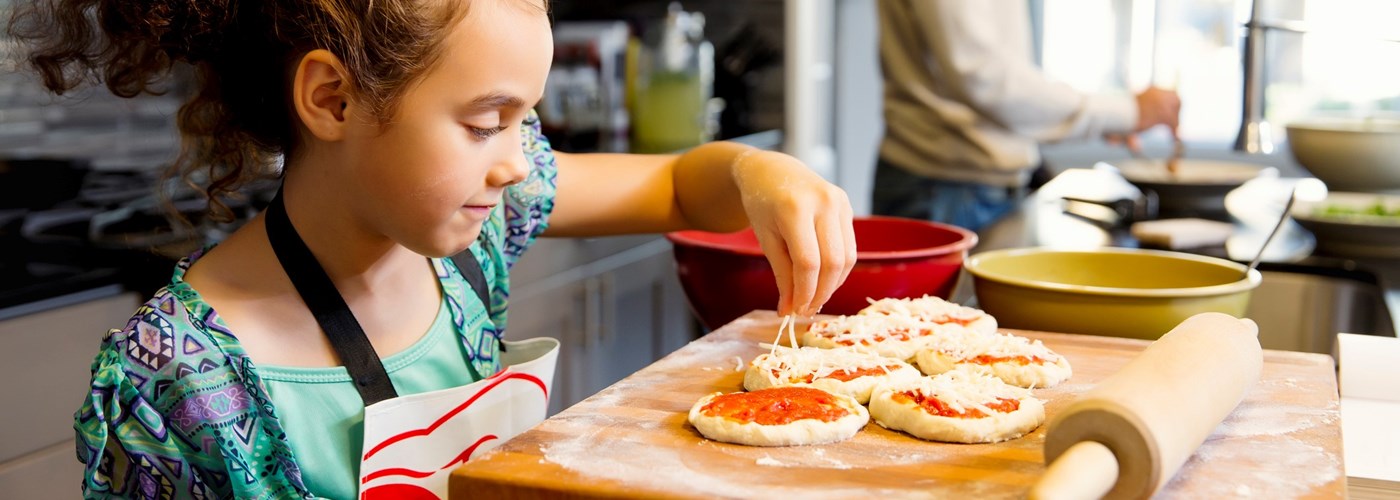7 ways to help a fussy eater
Learn how you can introduce your kids to a wider variety of foods...
It’s common for children to be picky eaters, especially in the early years. Although most grow out of it in time, fussy eating is often a big worry for parents.
Mealtimes can be especially challenging for autistic children and their families. Discover specialist recommendations to help parents introduce their children to a wider variety of foods.
How to help a fussy eater
Here’s how to help your child become more adventurous with food and develop healthy eating habits that will stay with them for life.
1. Keep meals conflict-free
Young children are beginning to assert their independence and one thing they can control is what they eat. The more you try to pressure them into trying a new food or let them see how much it matters to you, the more resistant they can become.
Don’t insist they stay at the table until they’ve tried ‘just another mouthful’ as you’re both going to get more frustrated. And don’t use pudding as a reward when they’ve eaten their vegetables. This gives them the message that sweet things are more valuable than other healthier foods. If you’re having trouble getting them to eat their main course, it may be best to not have pudding every day. Save it for a special treat instead.
2. Start with tiny portions
At first, just put a very small amount of a food you want to introduce on your child’s plate, separately from the foods that they’re happy eating. Don’t put any pressure on them to eat it.
Another good way to get kids to eat some veg is to give it to them in the form of little ‘starters’. These could be a few sticks of raw carrot or pepper with a small amount of dip, a few cherry tomatoes, or bite-sized bits of food they can eat with a cocktail stick. Serve them before they sit down at the table and while they’re absorbed in something else such as watching TV. We all know how we can eat mindlessly when we’re focused on a screen and you may find they gobble it up without any protest.
3. Regularly expose them to different foods
It’s important that children keep seeing foods on their plate, even if they won’t eat them. Young children often refuse to try unfamiliar foods because of the ‘neophobic food response’, an evolutionary mechanism that helps prevent them being poisoned by eating everything. Your child may avoid eating a certain food because of the colour or because it has marks on it, and they may also object to it touching another food on their plate.
Children often need to see a food, and other people eating it, multiple times before they feel confident to try it. That doesn’t mean you should serve broccoli every day of the week — just make sure they get a regular opportunity to sample it without feeling under any pressure.
4. Have fun in the kitchen
-
Get kids involved in preparing food. If your child has helped to make something, they’re more likely to feel they ‘own’ it and will want to try it. They’ll love threading bite-sized chunks of vegetables or fruit onto a kebab stick, tossing the salad, and counting out or measuring ingredients. Popping peas out of a pod is always a big favourite.
-
Get creative with food. Kids will enjoy making pictures or little creatures with food items, such as arranging blueberries into a worm shape, or making a turtle with a slice of kiwi, a green grape for a head and halved grapes for feet. You can find lots of inspiration by googling ‘food art’. For children, playing with food can often be a precursor to eating it.
-
Help them grow their own. Cress is good to start with as it’s easy and quick to grow. Just put some wet cotton wool at the bottom of a small container with low sides, press the cress seeds into the cotton wool and keep it damp. You should see the cress germinate in a couple of days and after a week, you can snip it off and use it in salads and egg sandwiches. Find more ideas here for fruit and vegetables that kids can grow and learn more about the health benefits of gardening.
5. Give them healthy snacks
Cutting out snacks in the hope it will make picky eaters hungry enough to eat whatever is on offer at mealtimes can backfire. It may just make them grouchy and more uncooperative when they do sit down to eat. It’s best to give a healthy snack mid-morning and afternoon, just not too close to their regular mealtime. A small, healthy snack could consist of an oatcake with a slice of cheese and some cherry tomatoes, a pot of plain yoghurt with some chopped fruit, or a dollop of hummus with vegetable sticks.
6. Provide healthy eating role models
Eat together as a family as often as you can. It’s important that children see adults eating a wide range of healthy foods. You can use other children as role models too. Kids often admire and look up to older children, and like to copy their behaviour, so think about who they hero worship – it could be a cousin or older sibling of a friend – and invite them round to eat. Just make sure you don’t make it too obvious by comparing their eating habits to the older child’s.
7. Keep the message consistent
Make sure anyone who looks after your child on a regular basis, such as school dinner supervisors, nursery staff, childminders and grandparents, are on board with your mealtime strategies, otherwise they could undermine all your hard work.
You can find lots more advice and tips on the Stop Fussy Eating website. Try some of our delicious, healthy recipes for adults and kids.
How to support autistic children with a limited diet
Caring for a child with autism can be demanding on many levels, and ensuring a healthy diet is no exception. People with autism often repeat behaviours or have limited and restricted interests. These types of behaviours can impact eating habits and food preferences. Autistic people may also experience increased sensitivity, and this can influence the variety of foods that they eat. Mealtimes can involve lots of people, noises, smells, and tastes which can be stressful.
Tips to support your child at mealtimes
If your child with autism finds mealtimes challenging, you might find these tips from Louise Durber, Special Needs Advisor, useful:
Remain calm and do not try to force your child to eat. Try not to let them know that their eating habits are causing you concern.
Continue to offer new foods. This will reduce the risk of them further restricting. Do this indirectly and without demands. You might start by encouraging them to smell the food then move to touching the food then putting the food on their lip, and finally tasting a small amount of the food. Keep on with small steps and introduce one new food at a time.
Make mealtimes predictable. Eating the same food brands or presenting the food in the same way will give a feeling of security. Consider having a designated seat for everyone at the table and use the same crockery and cutlery each time you eat.
Have a visible meal planner listing meals for the week ahead, this will allow certainty and give reassurance whilst allowing time for any objections in advance. You might want to use pictures and symbols to support understanding.
Keep a food diary, to help identify what foods are being incorporated into the diet. Any less than 20 foods could indicate a cause for concern and should be discussed with your GP.
Connect with other families experiencing similar issues such as Parent to Parent.
If you’re a Benenden Health member, you can access support and advice on our Care Planning and Social Care advice service.
About our healthcare
Benenden Health provides affordable private healthcare for everyone, giving you access to services such as our 24/7 GP Helpline and Mental Health Helpline straight away. Once you’ve been a member for six months you can request access to diagnostic consultations and tests.
You'll also have access to a wealth of health and wellbeing articles, videos and advice on a range of health issues.


